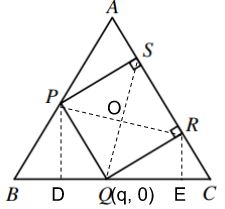“An equilateral triangle ABC has side length 2. A square,PQRS, is such that P lies on AB, Q lies on BC, and R and S lie on AC as shown. The points P, Q, R, and S move so that P, Q and R always remain on the sides of the triangle and S moves from AC to AB through the interior of the triangle. If the points P, Q, R and S always form the vertices of a square, show that the path traced out by S is a straight line parallel to BC.”

The CEMC’s solution seems a little tricky. Here I want to discuss a method using analytic geometry and congruent triangles.
Place the equilateral triangle ABC on a coordinate plane such that ![]() and
and ![]() . Let the coordinates of
. Let the coordinates of ![]() be
be ![]() . The problem is actually asking for showing that whatever the value of
. The problem is actually asking for showing that whatever the value of ![]() is, the
is, the ![]() -coordinate of
-coordinate of ![]() is constant.
is constant.
Let the coordinates of other points be ![]() ,
, ![]() ,
, ![]() ,
, ![]() ,
, ![]() and
and ![]() .
.
Since the point O is the midpoint of SQ and the y-coordinate of Q is always 0, we just need to show the ![]() is constant, by the midpoint formula of analytic geometry. Since O is also the midpoint of PR, it’s equivalent to show
is constant, by the midpoint formula of analytic geometry. Since O is also the midpoint of PR, it’s equivalent to show ![]() is constant.
is constant.
Plugging in the coordinates of P, Q to the equations of line AB and AC, we have the following equations.
![]() (1)
(1)
![]() (2)
(2)
Notice that ![]() , then we have the following connections between the coordinates of P and Q.
, then we have the following connections between the coordinates of P and Q.
![]() (
(![]() ) =>
) => ![]() (3)
(3)
![]() (
(![]() ) =>
) => ![]() (4)
(4)
Plugging the equations (3)(4) to (1)(2), we have the following equations.
![]() (5)
(5)
![]() (6)
(6)
(5)+(6) shows that ![]() .
.
Therefore ![]() is constant. Done.
is constant. Done.
Recent Comments